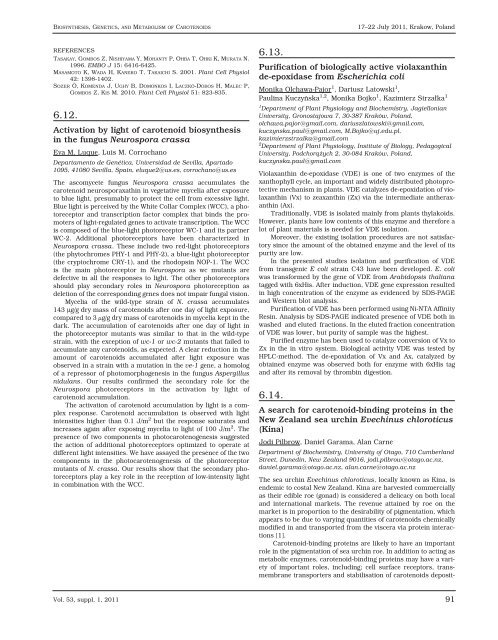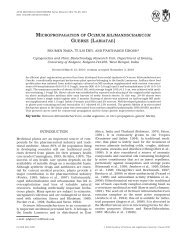ACTA BIOLOGICA CRACOVIENSIA
ACTA BIOLOGICA CRACOVIENSIA
ACTA BIOLOGICA CRACOVIENSIA
Create successful ePaper yourself
Turn your PDF publications into a flip-book with our unique Google optimized e-Paper software.
BIOSYNTHESIS, GENETICS, AND METABOLISM OF CAROTENOIDS<br />
REFERENCES<br />
TASAKAY, GOMBOS Z, NISHIYAMA Y, MOHANTY P, OHBA T, OHKI K, MURATA N.<br />
1996. EMBO J 15: 6416-6425.<br />
MASAMOTO K, WADA H, KANEKO T, TAKAICHI S. 2001. Plant Cell Physiol<br />
42: 1398-1402.<br />
SOZER Ö, KOMENDA J, UGHY B, DOMONKOS I, LACZKÓ-DOBOS H, MALEC P,<br />
GOMBOS Z, KIS M. 2010. Plant Cell Physiol 51: 823-835.<br />
6.12.<br />
Activation by light of carotenoid biosynthesis<br />
in the fungus Neurospora crassa<br />
Eva M. Luque, Luis M. Corrochano<br />
Departamento de Genética, Universidad de Sevilla, Apartado<br />
1095, 41080 Sevilla, Spain, eluque2@us.es, corrochano@us.es<br />
The ascomycete fungus Neurospora crassa accumulates the<br />
carotenoid neurosporaxathin in vegetative mycelia after exposure<br />
to blue light, presumably to protect the cell from excessive light.<br />
Blue light is perceived by the White Collar Complex (WCC), a photoreceptor<br />
and transcription factor complex that binds the promoters<br />
of light-regulated genes to activate transcription. The WCC<br />
is composed of the blue-light photoreceptor WC-1 and its partner<br />
WC-2. Additional photoreceptors have been characterized in<br />
Neurospora crassa. These include two red-light photoreceptors<br />
(the phytochromes PHY-1 and PHY-2), a blue-light photoreceptor<br />
(the cryptochrome CRY-1), and the rhodopsin NOP-1. The WCC<br />
is the main photoreceptor in Neurospora as wc mutants are<br />
defective in all the responses to light. The other photoreceptors<br />
should play secondary roles in Neurospora photoreception as<br />
deletion of the corresponding genes does not impair fungal vision.<br />
Mycelia of the wild-type strain of N. crassa accumulates<br />
143 μg/g dry mass of carotenoids after one day of light exposure,<br />
compared to 3 μg/g dry mass of carotenoids in mycelia kept in the<br />
dark. The accumulation of carotenoids after one day of light in<br />
the photoreceptor mutants was similar to that in the wild-type<br />
strain, with the exception of wc-1 or wc-2 mutants that failed to<br />
accumulate any carotenoids, as expected. A clear reduction in the<br />
amount of carotenoids accumulated after light exposure was<br />
observed in a strain with a mutation in the ve-1 gene, a homolog<br />
of a repressor of photomorphogenesis in the fungus Aspergillus<br />
nidulans. Our results confirmed the secondary role for the<br />
Neurospora photoreceptors in the activation by light of<br />
carotenoid accumulation.<br />
The activation of carotenoid accumulation by light is a complex<br />
response. Carotenoid accumulation is observed with light<br />
intensities higher than 0.1 J/m 2 but the response saturates and<br />
increases again after exposing mycelia to light of 100 J/m 2 . The<br />
presence of two components in photocarotenogenesis suggested<br />
the action of additional photoreceptors optimized to operate at<br />
different light intensities. We have assayed the presence of the two<br />
components in the photocarotenogenesis of the photoreceptor<br />
mutants of N. crassa. Our results show that the secondary photoreceptors<br />
play a key role in the reception of low-intensity light<br />
in combination with the WCC.<br />
Vol. 53, suppl. 1, 2011<br />
17–22 July 2011, Krakow, Poland<br />
6.13.<br />
Purification of biologically active violaxanthin<br />
de-epoxidase from Escherichia coli<br />
Monika Olchawa-Pajor1 , Dariusz Latowski1 ,<br />
Paulina Kuczyńska1,2 , Monika Bojko1 , Kazimierz Strzałka1 1Department of Plant Physiology and Biochemistry, Jagiellonian<br />
University, Gronostajowa 7, 30-387 Kraków, Poland,<br />
olchawa.pajor@gmail.com, dariuszlatowski@gmail.com,<br />
kuczynska.paul@gmail.com, M.Bojko@uj.edu.pl,<br />
kazimierzstrzalka@gmail.com<br />
2Department of Plant Physiology, Institute of Biology, Pedagogical<br />
University, Podchorążych 2, 30-084 Kraków, Poland,<br />
kuczynska.paul@gmail.com<br />
Violaxanthin de-epoxidase (VDE) is one of two enzymes of the<br />
xanthophyll cycle, an important and widely distributed photoprotective<br />
mechanism in plants. VDE catalyzes de-epoxidation of violaxanthin<br />
(Vx) to zeaxanthin (Zx) via the intermediate antheraxanthin<br />
(Ax).<br />
Traditionally, VDE is isolated mainly from plants thylakoids.<br />
However, plants have low contents of this enzyme and therefore a<br />
lot of plant materials is needed for VDE isolation.<br />
Moreover, the existing isolation procedures are not satisfactory<br />
since the amount of the obtained enzyme and the level of its<br />
purity are low.<br />
In the presented studies isolation and purification of VDE<br />
from transgenic E coli strain C43 have been developed. E. coli<br />
was transformed by the gene of VDE from Arabidopsis thaliana<br />
tagged with 6xHis. After induction, VDE gene expression resulted<br />
in high concentration of the enzyme as evidenced by SDS-PAGE<br />
and Western blot analysis.<br />
Purification of VDE has been performed using Ni-NTA Affinity<br />
Resin. Analysis by SDS-PAGE indicated presence of VDE both in<br />
washed and eluted fractions. In the eluted fraction concentration<br />
of VDE was lower, but purity of sample was the highest.<br />
Purified enzyme has been used to catalyze conversion of Vx to<br />
Zx in the in vitro system. Biological activity VDE was tested by<br />
HPLC-method. The de-epoxidation of Vx and Ax, catalyzed by<br />
obtained enzyme was observed both for enzyme with 6xHis tag<br />
and after its removal by thrombin digestion.<br />
6.14.<br />
A search for carotenoid-binding proteins in the<br />
New Zealand sea urchin Evechinus chloroticus<br />
(Kina)<br />
Jodi Pilbrow, Daniel Garama, Alan Carne<br />
Department of Biochemistry, University of Otago, 710 Cumberland<br />
Street, Dunedin, New Zealand 9016, jodi.pilbrow@otago.ac.nz,<br />
daniel.garama@otago.ac.nz, alan.carne@otago.ac.nz<br />
The sea urchin Evechinus chloroticus, locally known as Kina, is<br />
endemic to costal New Zealand. Kina are harvested commercially<br />
as their edible roe (gonad) is considered a delicacy on both local<br />
and international markets. The revenue attained by roe on the<br />
market is in proportion to the desirability of pigmentation, which<br />
appears to be due to varying quantities of carotenoids chemically<br />
modified in and transported from the viscera via protein interactions<br />
[1].<br />
Carotenoid-binding proteins are likely to have an important<br />
role in the pigmentation of sea urchin roe. In addition to acting as<br />
metabolic enzymes, carotenoid-binding proteins may have a variety<br />
of important roles, including; cell surface receptors, transmembrane<br />
transporters and stabilisation of carotenoids deposit-<br />
91












